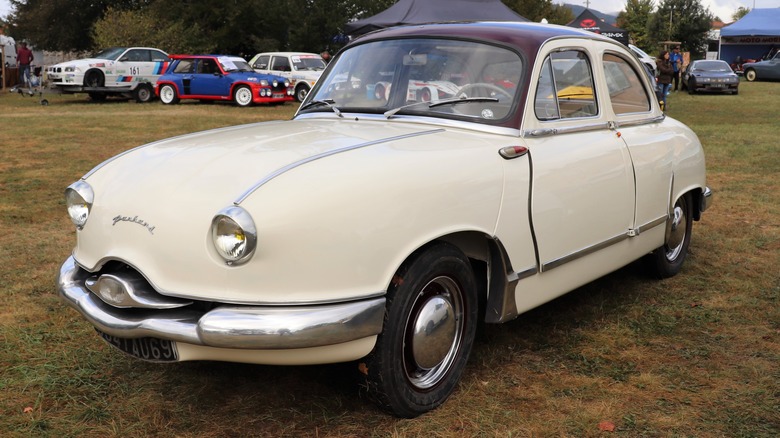This Peculiar Panhard Dyna Z Was The Result Of Rigorous Wind Tunnel Testing
The Panhard Dyna Z, produced from 1954 to 1959, was an advanced vehicle for its time. Although most Americans are unfamiliar with the former French brand, Panhard started out as Panhard & Levassor back in 1887, the dawn of the automotive age. The company started out licensing Daimler's rear-engined layout, but it would be the first to use what became known as the Systeme Panhard, which placed the engine in the front of the chassis and the transmission behind it, with the final drive going to the rear wheels. This layout would become standardized across the auto industry, until the packaging advantages of front-wheel drive became dominant in the latter half of the 1900s — but Panhard also got there early with the Dyna Z.
The Dyna Z was the successor to and a further evolution of the aluminum-alloy bodied, two-cylinder Dyna X, which had been made from 1946 through 1953 but looked like an old-fashioned car from the 1930s. The new Dyna Z was designed to achieve the highest levels of vehicle efficiency, providing plenty of interior space while using the bare minimum of fuel to propel it. This was a primary requirement for cars made in post-war France, when raw materials and fuel were scarce. The Dyna X and Z vehicles had aluminum bodies simply because steel was rationed, but aluminum was not, so greater supplies of aluminum were available to French automakers. This changed in 1957 as the Dyna Z switched to a heavier steel body for cost reasons.
The Panhard Dyna Z was shaped in the wind tunnel
The precursor of the Panhard Dyna Z was the Dynavia concept car, which debuted at the 1948 Paris Auto Salon. The Dynavia was an advanced aerodynamic design by Bionier, based on the natural movements of birds and fish. Admired by both the public and the press, the Dynavia signaled an acceptance of this advanced aerodynamic look for Panhard's vehicles. Bionier was assigned to design a more production-practical body for the upcoming Dyna Z.
The Dyna Z had a smooth, modern look, compared to the Dyna X's old-school separate fenders and awful aerodynamics. The Dyna Z was derived from a platform engineered by J.A. Gregoire (also used by the Dyna X) and a new body design by Louis Bionier. Panhard licensed the use of the Gregoire-designed platform and modified it over the years. It would form the foundation of all Panhard cars made through the end of the brand's passenger-car production.
Panhard understood early on how superior aerodynamics could improve the performance and economy of their vehicles. The Dyna Z's body was tested in a wind tunnel and achieved an astounding (for the time) drag coefficient of 0.26, which is admirable even by today's standards (the current Toyota Prius comes in at 0.27). The Volkswagen Beetle, by comparison, had a much poorer 0.48 coefficient of drag. Aerodynamically, the Panhard Dyna Z was way ahead of its time. Panhard advertised a top speed of 80 MPH and fuel economy of 39 MPG. Not advertised was the 24-second 0-60 MPH time.
The Panhard Dyna Z was efficient in many other ways
The Panhard Dyna Z engine was also optimized for efficiency. It was an air-cooled, horizontally opposed, four-stroke two-cylinder engine with a displacement of 851cc and an output of 42 horsepower. An upgraded 50-horsepower "Tigre" version came later. The engine featured roller bearings for both crankshaft and connecting rods to minimize friction and extend engine life. A one piece casting combined each cylinder with its cylinder head, eliminating any possibility of a blown head gasket. The aluminum cylinders had cast-iron liners for reduced wear, while the crankcase was also cast in a single piece.
There was no radiator required due to the engine's air-cooled design, which also aided the front end's aero. For improved space utilization, the Dyna Z's engine, four-on-the-tree manual transmission, and front-wheel driven final drive unit were all placed ahead of the front axle.
Other interesting features of the Panhard Dyna Z include a fully padded dashboard, front suicide doors (a car feature that is probably gone forever), a nicely sculptured plastic instrument surround, and an ignition key slot located underneath the steering wheel's hub. Front and rear bench seats provide seating for six very friendly people. Around 120,000 Dyna Z's were produced from 1954 through 1959.
The Dyna Z was succeeded by the face-lifted PL-17 in 1960. Due to extremely poor cost accounting and a tie-up with that other innovative French automaker Citroën that ended as a takeover, Panhard was starved of funds. No further new models were produced. The last Panhard-branded vehicles were sold in May 1965 (though the Panhard 1964 LM64 did make an appearance at Le Mans before the company went under).


